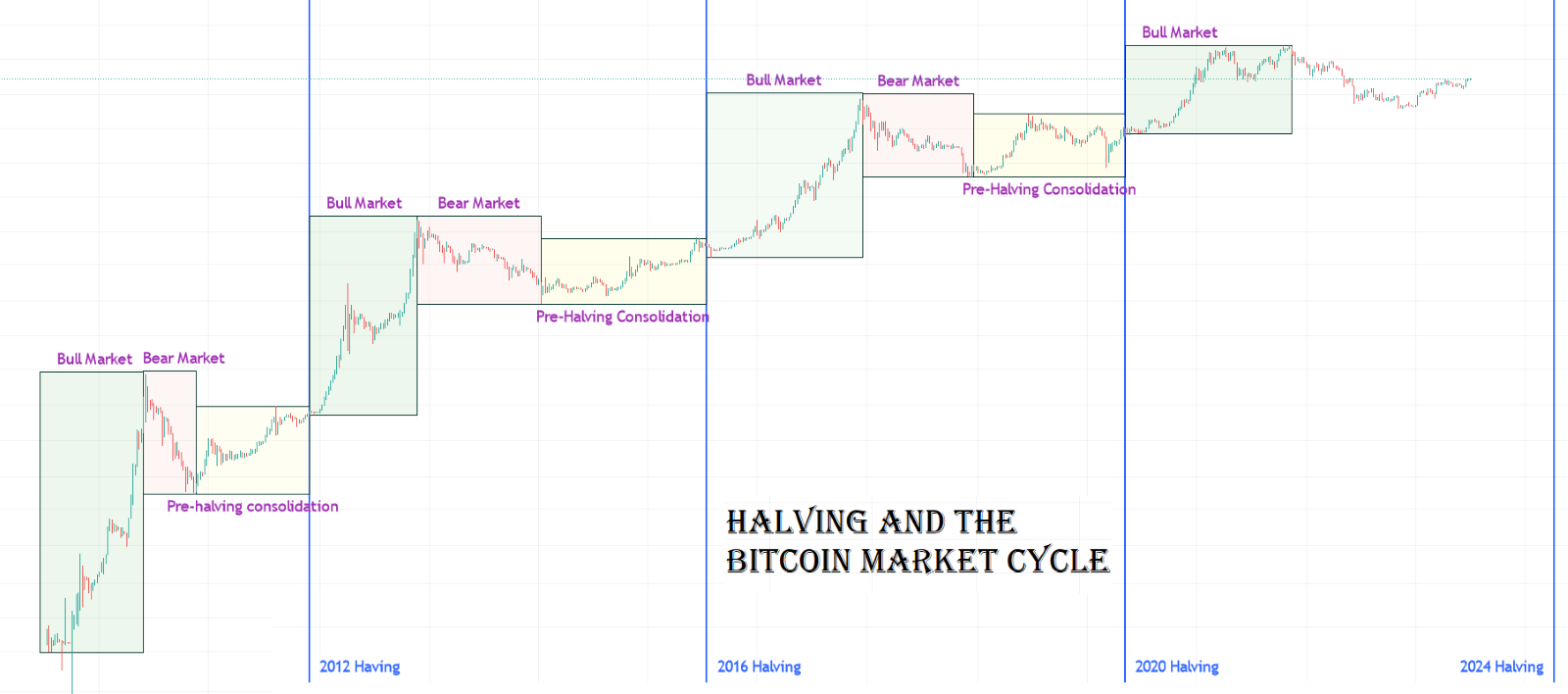Bitcoin Halving: What You Need to Know
Anyone who has spent time researching cryptocurrencies would have heard of the term ‘Bitcoin halving.’ In the Web3 ecosystem, few events generate as much excitement and anticipation as this. It’s one of the fundamental aspects of BTC's long-term price prediction and has proven reasonably reliable thus far.
The term Bitcoin halving refers to the 50% reduction in block rewards paid to miners, reducing the overall supply of new Bitcoins to the market. The theory behind this is that as the demand remains the same and the supply decreases, it will eventually lead to an increase in price.
Overview
The pseudonymous Satoshi Nakamoto created Bitcoin in January 2009. It was designed to be a digital currency that operates without the need for interference from any government. The decentralized nature of Bitcoin meant that it needed to be operated by individual miners from across the globe. A reward system was established to incentivize these miners, where they receive a certain amount of Bitcoin for adding a block to the blockchain. This reward is known as the block reward.
Unlike traditional fiat currency, where the supply keeps growing infinitely, reducing the value of money over time, Bitcoin operates on a fixed supply model. The total number of Bitcoin is capped at 21 million BTC, meaning the supply of Bitcoin to miners cannot stay the same forever. This is where halving comes into play.
When Bitcoin was created, the halving cycle was programmed into the network as one of its key features. After 210,000 blocks get added to the Bitcoin network, which roughly takes four years, the Bitcoin reward paid to the miners is slashed by half. This reduces the Bitcoin supply over time and ensures the supply cap remains intact.
Below is a table displaying the miner reward from 2008 to 2036.
Halving Cycle | Block Height | Reward | Date |
Initial Reward – 50 BTC | |||
First Halving | 210,000 | 25 BTC | 28 Nov 2012 |
Second Halving | 420,000 | 12.5 BTC | 9 Jul 2016 |
Third Halving | 630,000 | 6.25 BTC | 11 May 2020 |
Fourth Halving | 840,000 | 3.125 BTC | Apr 2024 (Estimate) |
Fifth Halving | 1,050,000 | 1.5625 BTC | Mar 2028 (Estimate) |
Sixth Halving | 1,260,000 | 0.78125 BTC | Feb 2032 (Estimate) |
Seventh Halving | 1,470,000 | 0.390625 BTC | Jan 2036 (Estimate) |
The Halving's Impact on Bitcoin Price
According to basic economic principles, when the supply decreases while the demand remains constant, a price increase results. This is precisely what we notice after every Bitcoin halving event.
In a typical Bitcoin market cycle, there are three distinct phases: the bull market, the bear market, and the consolidation phase, with the halving event marking the transition between each market cycle. The chart below shows the interplay between the halving and its market cycle that has played out over the past 12 years.

Usually, the bull market starts after the halving event. As the supply gets cut in half, the price slowly starts increasing. This increasing price attracts the mainstream audience's attention, leading to an increased investment in Bitcoin. Eventually, this surge in demand and lower supply results in the price going parabolic and reaching a new all-time high.
Following the bull market's peak, we witness a selling to increase traders and investors who purchased their Bitcoin in the previous market cycle, booking their profit. This marks the beginning of the bear market phase, where BTC corrects sharply, losing anywhere between 70% to 85% of its value.
The third phase is the pre-halving consolidation, where investors who know about the Bitcoin halving cycle start buying BTC at lower levels in anticipation of the next market cycle. This results in Bitcoin recovering from the lows of the bear market while remaining below the highs of the previous bull market. And finally, the halving happens, and the whole cycle repeats.
Using Halving as Investment Strategy
The Bitcoin halving is widely regarded by many crypto investors as a significant indicator of changes in trading momentum, not just for Bitcoin but also for the broader cryptocurrency market. Seasoned traders who have been part of the ecosystem for a considerable period often take advantage of this event. They strategically buy Bitcoin during the bear market lows, wait for the price increase post-halving, and sell it at a profit. Over the past 12 years, this pattern has played out as expected, resulting in a substantial increase in Bitcoin’s price after each halving event.
The table below shows the rough estimate of the return from halving to the next bull market high.
Halving | Return from halving to All time high |
2012 | Over 10,000% |
2016 | Over 3,000% |
2020 | Over 500% |
However, we must remember that past indicators do not guarantee future performance. It is also worth noting that the percentage increase following each halving has decreased with each cycle. Therefore, it’s essential to understand that using halving as a strategy carries inherent risks. Thorough research, risk management, and understanding of current market conditions are important for making profitable trades in the volatile crypto markets.
Other Coins with Halving Events
Bitcoin’s success with halving rewards inspired several other blockchains to adopt a similar approach. Let’s look at some other prominent coins that have implemented halving rewards.
Litecoin halving is probably the second most anticipated event in the crypto calendar. However, it is a distant second. Its rewards are also halved every four years, with the next halving event scheduled for August 2023. DASH is another coin where halving will likely happen in Sep 2023, and Zcash’s ZEC reward halving is scheduled for October 2023.
It is important to note that the impact of halving on these coins is generally more limited than Bitcoin's. Most of these coins tend to rise in value only when Bitcoin goes up, and the broader crypto market enters the bull market phase.
Downsides to Bitcoin Halving
Despite its many advantages, the halving rewards mechanism is not without its risks. One such risk, in the long run, pertains to miner profitability. On the one hand, the Bitcoin hash rates, which represent the computational power dedicated to mining, are continuing to increase. On the other, the rewards are continuing to decrease.
Currently, mining a Bitcoin block yields a reward of 6.25 BTC. However, by 2036, the same block would only generate 0.390625 BTC, a substantial 93% reduction compared to the current reward. If the price of BTC has not increased sufficiently by that point, mining will become unprofitable, leading to miners abandoning the network.
Conclusion
Halving rewards is one of the fundamental features of Bitcoin. It allows the network to cap the maximum supply while simultaneously making the coin deflationary and helping increase its worth. It has also provided investors with a market cycle many have used to time their entry and exit into BTC. While the halving miner rewards could pose challenges for Bitcoin in the future, a new source of revenue for miners will likely emerge to offset the falling mining rewards as the Bitcoin ecosystem continues to evolve. The ongoing debate around Bep-20 tokens is one such new emerging revenue model that could sustain Bitcoin in the long term.
Discover SynFutures' crypto derivatives products: www.synfutures.com/.
Disclaimer: SynFutures Academy does not guarantee the reliability of the site content and shall not be held liable for any errors, omissions, or inaccuracies. The opinions and views expressed in any SynFutures Academy article are solely those of the author(s) and do not reflect the opinions of SynFutures. The SynFutures Academy articles are for educational purposes or information only. SynFutures Academy has no relationship to the projects mentioned in the articles, and there is no endorsement for these projects. The information provided on the site does not constitute an endorsement of any of the products and services discussed or investment, financial, or trading advice. A qualified professional should be consulted prior to making financial decisions.




